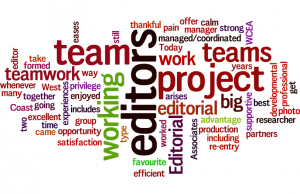There are many editing and plain language conferences planned this year.
Teamwork
 Holidays are a great tonic—especially when work can be completely banished. I’ve just returned from sun, sea, and sand where the only thing I had to remember was the plot of the novel I was reading. But returning to work can be bruising to the blissed-out brain. I came back to a big textbook project, and once again, I’m thankful for the privilege of working with an excellent, supportive editorial team that eases some of the pain of re-entry.
Holidays are a great tonic—especially when work can be completely banished. I’ve just returned from sun, sea, and sand where the only thing I had to remember was the plot of the novel I was reading. But returning to work can be bruising to the blissed-out brain. I came back to a big textbook project, and once again, I’m thankful for the privilege of working with an excellent, supportive editorial team that eases some of the pain of re-entry.
My favourite type of project is one where I get to work with other editors. Over the years, I’ve worked on many editorial teams and managed/coordinated some. This time I’m not the project manager (PM) but one of the developmental editors. The team includes an efficient and calm PM, two other editors (including one of my WCEA partners, Georgina Montgomery), a production editor, and a photo researcher.
This is the last major project of my editing career, so I’m offering some observations from my experiences as both a PM and team member—perhaps they’ll be helpful for those who are new to team projects.
For the PM:
- You probably already know about all the technical aspects of project management—scheduling and coordinating various levels of editing, art, and photos—but what may surprise you is how much time you will spend dealing with your team members.
- Communicating regularly with your team actually saves more time than contacting them only occasionally whenever there’s a change or crisis. Weekly conference calls work well (through whatever technology you prefer). Everyone gets the same info at the same time and can ask questions that other team members would benefit from hearing.
- If an editor discovers that the work will take longer than expected, discuss how to get it all done. Perhaps you can provide extra support, such as stepping in to deal with a difficult author or finding someone to do non-editorial tasks like completing charts.
- Be prepared to deal with some team members needing a lot of one-on-one support, whether it’s constant reassurance, frequent explanations, or a shoulder to cry on.
- Avoid pointing fingers when things go wrong unless there’s a good reason for a reprimand. Most editors are pretty good at beating themselves up over mistakes—don’t add to the agony.
For the team member:
- Connect with your PM regularly. Make an extra effort if your PM isn’t as communicative as you would like.
- Ask for what you need if you haven’t received it yet (e.g., schedule, style sheet)—and keep asking until you get it.
- If you need to learn new technology, be brave—do it. If you need training, the PM should arrange for it.
- Let the PM know as soon as you think you might not be able to meet a deadline and help figure out ways to find a solution (e.g., identify where another editor could easily step in to help, such as compiling the glossary).
- Take advantage of the opportunity to interact with other editors. How much this occurs depends on the project and the individuals involved. Think of them as a valuable resource—when the PM isn’t available, they may be able to answer your questions. Remember that you are not alone.
West Coast Editorial Associates formed way back in 1992 because a group of editors so enjoyed the professional satisfaction that came from working as a team on a big textbook project. Today we’re still going strong, working together and with other editors whenever the opportunity arises. Editorial teams can offer one of the best work experiences—take advantage of them when you can.



